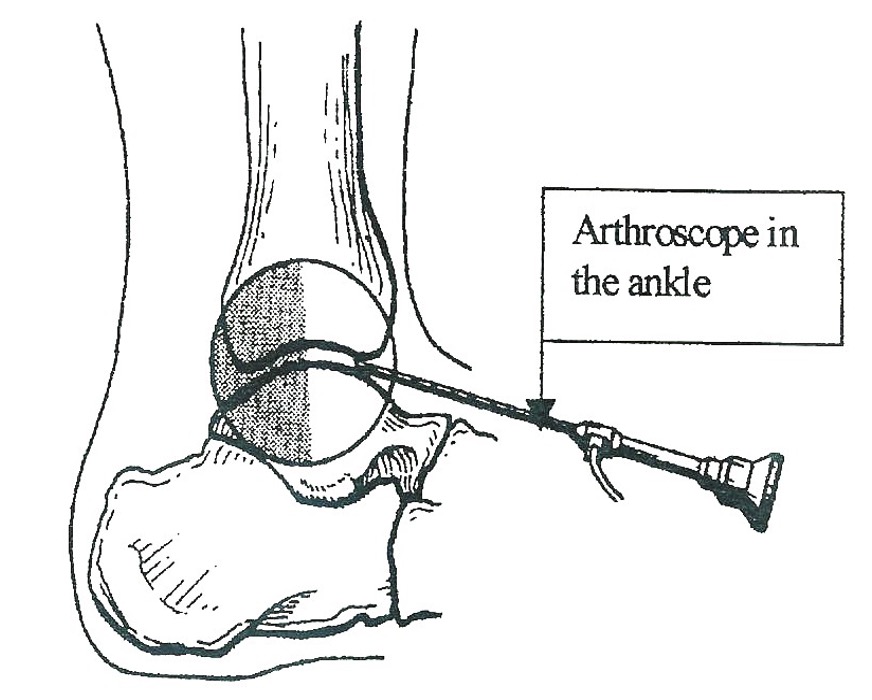Ankle Arthroscopy
Book a free Intro call today to discuss options for Ankle Arthroscopy - Email: Mrshariff-sec@outlook.com Tel: 07500 938115
What is Ankle Arthroscopy?

What to expect after an Ankle Arthroscopy?
Following the procedure a padded bandage will be applied. The puncture wounds will have a stitch in place – this is to keep the edges of the incisions together. Stitches are removed in clinic about 14 days following the procedure. It is common for the joint to become inflamed following the arthroscopy. It is advisable to elevate the leg & limit the amount of walking for two weeks following the procedure, then gradually increase as able. Following some procedures, a cast may be applied to rest the ankle for two weeks following the surgery; crutches may be required for a short duration.
Important Post-Operative Advice after an Ankle Arthroscopy
IMPORTANT POST OPERATIVE ADVICE
Gently mobilise the ankle as soon as able (this prevents stiffness and strengthens muscles). A physiotherapist may assess walking and explain exercises that are effective to aid recovery. Refer to end of leaflet for exercise regime.
Wound(s) must be kept dry for up to 2 to 3 weeks following the procedure. Keep wound sites covered. A mepore dressing will be in place following procedure. However, it is possible to take a shower after 48 hours providing a waterproof dressing is applied. Avoid taking a ‘bath’.
Driving – Manual cars can be driven usually 7 days following arthroscopy if the ankle feels comfortable. Automatic cars may be driven sooner in those who have surgery on the left ankle only. It is important to be able to perform an emergency stop. You MUST notify your insurance company of the procedure that has been undertaken to ensure that cover is valid.
Sport – gentle activity can often be resumed at approximately 6 weeks. Competitive sport such as football, rugby or squash may take longer but also depends on the type of surgery carried out. Ask for advice from doctor/nurse.
Recovery to pre-operative state usually takes 3-6 weeks for soft tissue procedures, and twice this time for bony procedures. However, recovery is unique to the individual.
Following the RICE Regime
REST
Rest when able. Returning to work will depend on your type of employment, the procedure that you have undergone, individual circumstances and speed of recovery. Those who have an office or sedentary type of employment will usually be able to return to work within 7 days of procedure. Those whose employment involves long periods on their feet may be off for 4 weeks.
ICE
Ice application in the form of an ice pack may help reduce swelling and assist with pain relief. It is important to protect the affected area with a damp towel prior to application; often a bag of frozen peas is very effective! When the wound has healed & no ooze is present fill a bowl with water, add some ice cubes and submerge your ankle in this (do not leave your ankle for longer than 10 minutes). This may be repeated up to four times a day.
COMPRESSION
Compression in the form of a tubigrip support should be worn during the day. It provides support to the ankle and it also helps reduce post operative swelling. The tubigrip must not be worn at night.
ELEVATE
Elevate when able. It is advised to keep the affected area above groin level as this helps to significantly reduce swelling. Anti inflammatory pain relief such as nurofen, ibuprofen combined with paracetamol is effective – ask for advice from your doctor before taking any medications.
Kent’s Holistic Foot & Ankle specialists
The Sajid Shariff clinic is a private orthopaedic clinic based in SE London and Kent that specialises in surgical and non-surgical treatment of foot and ankle conditions including ankle arthroscopy.
Keep an eye on the shape of your feet; if you see changes see a doctor to find out if there are any recommendations to prevent hallux valgus from forming

Use a variety of exercises to stretch your feet and calves

Try to avoid shoes that have a heel or pointed toe

